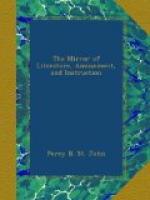Under our Saxon ancestors, by whom the Cinque Ports were first chartered, all the havens were open and in good condition, in which state they were found by the Normans, who confirmed to the Ports their ancient privileges. Through several centuries their prosperity continued to increase; the towns were well built, fully inhabited, and in possession of a lucrative and extensive commerce; they had many fine ships constantly employed, and abounded with hardy and intrepid seamen; opulence was visible in their streets, and happiness in their dwellings. But times have sadly changed with them. Let us inquire into the causes which led to their decay. The first cause is the failing of their several havens, some by the desertion of the sea, and others from being choked up by the impetuosity of that boisterous and uncertain element. The second is the change that has taken place in the method of raising and supporting a national marine, now no longer entrusted to the Cinque Ports; and the third was from the invasion of their privileges with respect to trade.
It is evident from their history that the Cinque Ports were once safe and commodious harbours, the decay of which is attributable chiefly to the practice of inning or gaining land from the sea; the first attempts at which were made upon the estuary into which the river Rother discharges itself, between Lydd and Romney. As there were marshes here in the time of the Saxons, and as almost all the property in the neighbourhood belonged to the church, it is most probable that this mischievous practice was first introduced by their clergy. By various operations the river was forced into a new channel, and a very strong fence, called a ree, was built to ensure its perpetual exclusion. The success which attended this operation roused the cupidity of the Archbishops of Canterbury, who considering it as an excellent method for increasing their property, continued to make large and successful inroads on the sea, till the tract of land so gained may be computed at between fifty and sixty thousand acres, now become rich and fertile pastures, producing good rents, and extremely valuable.




